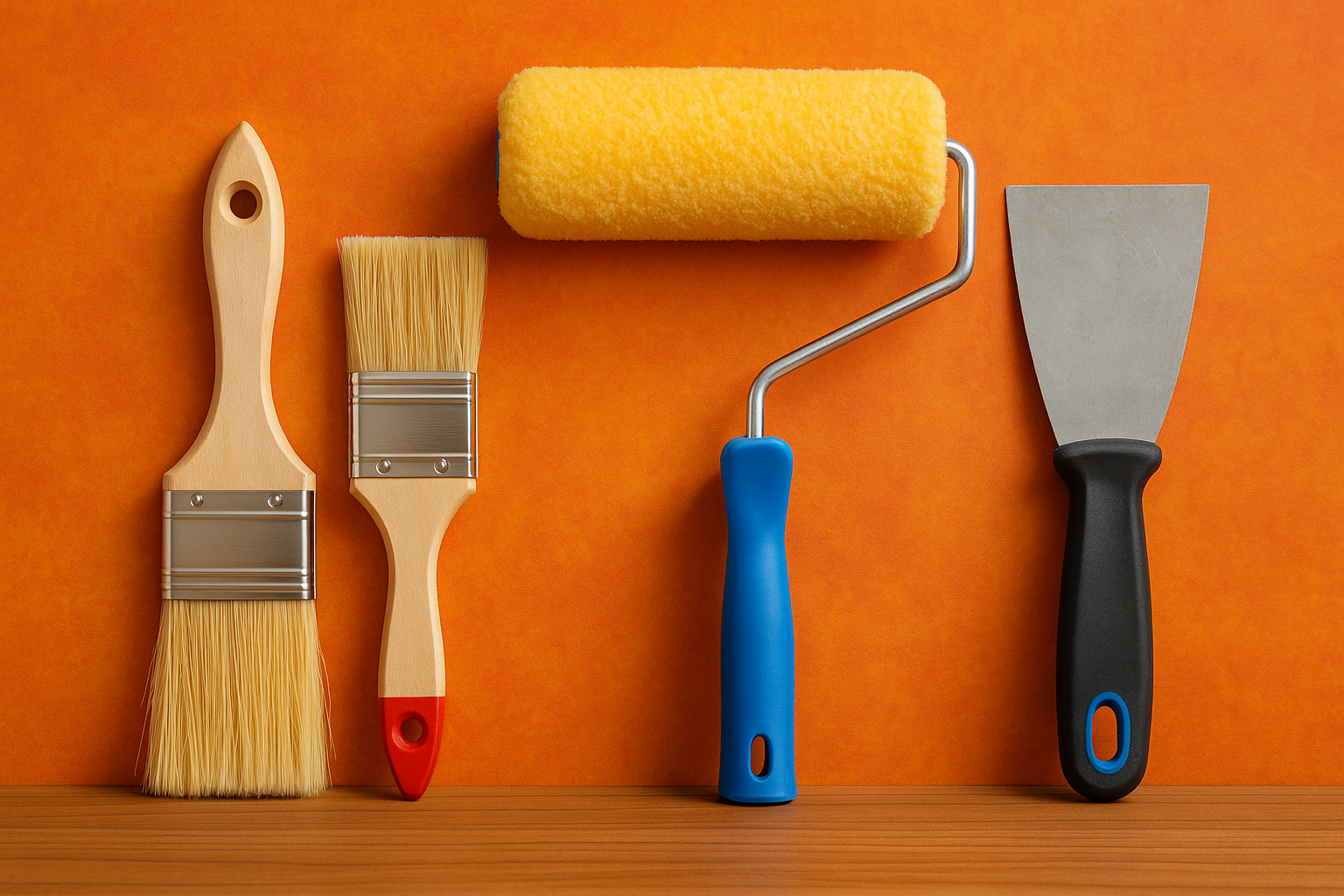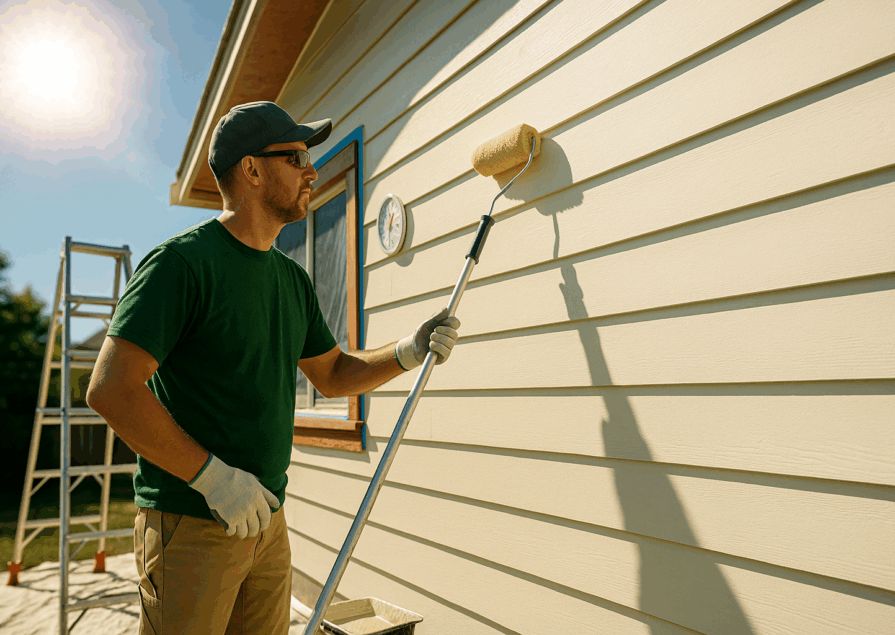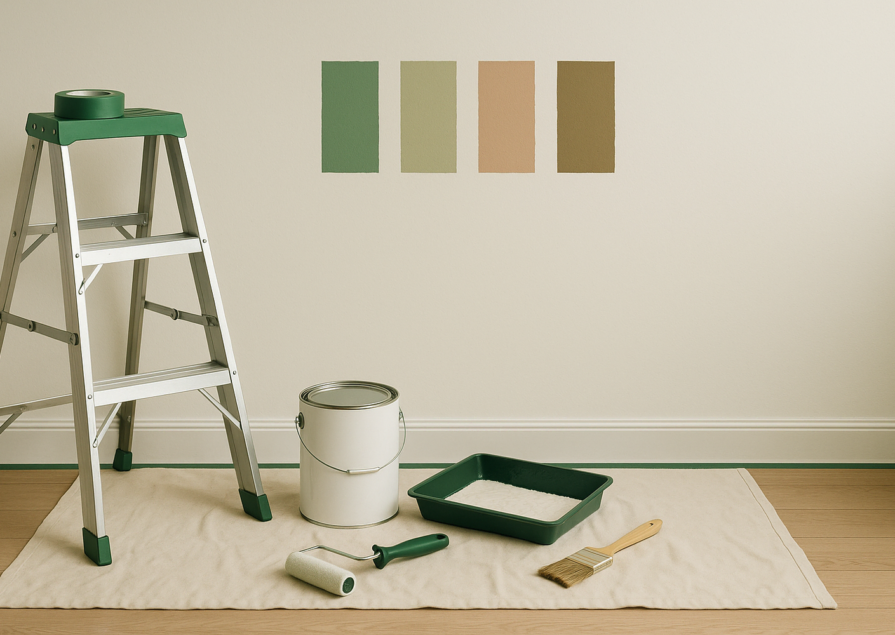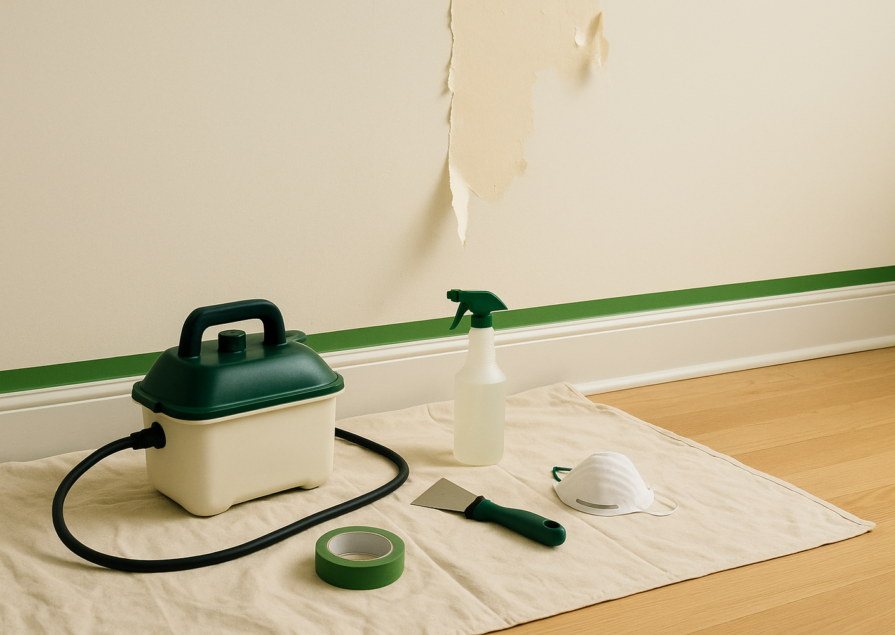Painting tools are essential to achieving a professional finish in any painting project. Whether you’re a professional painter or a DIY enthusiast, the condition of your tools directly impacts the quality of your work. Well-maintained tools ensure smooth application, reduce the chances of mistakes, and save time by functioning efficiently. Moreover, proper care extends the lifespan of your tools, saving you money in the long run by avoiding frequent replacements. Ultimately, investing in the maintenance of your painting tools is investing in the success of your projects.
Overview of the Guide
This guide will help you determine when it’s time to replace your painting tools, recognize the signs of wear and tear, and understand the factors that influence the lifespan of these essential items. We’ll start by exploring the different types of painting tools, followed by an examination of the key factors that affect their longevity. By the end of this guide, you’ll have a clear understanding of how to maximize the life of your tools and when it’s time to replace them to maintain the highest standards in your work.
The Lifespan of Painting Tools
Types of Painting Tools
Brushes
Brushes are a cornerstone of any painter’s toolkit, used for detailed work, cutting in edges, and applying finishes. The lifespan of a brush depends on its quality, the materials it’s made from, and how well it’s maintained. Natural bristle brushes can last for multiple projects if properly cared for, while synthetic brushes might wear out more quickly. Signs that a brush needs replacement include frayed bristles, a loss of shape, and difficulty in applying paint smoothly.
Rollers
Rollers are indispensable for covering large areas quickly and evenly. They come in various materials, each suited for different types of paint and surfaces. The longevity of a roller largely depends on the quality of the roller cover, how it’s cleaned, and how frequently it’s used. Over time, rollers can become matted or develop clumps, leading to uneven application. Regular inspection of the roller’s condition is essential to determine when it’s time for a replacement to ensure a flawless finish.
Scrapers
Scrapers are used to remove old paint, smooth surfaces, and prepare walls for new coats of paint. These tools endure significant wear, especially when used on rough surfaces. The edge of a scraper can become dull or rusted, reducing its effectiveness and making the task more labor-intensive. Regular sharpening and proper storage can extend the life of a scraper, but eventually, even the most durable scrapers will need to be replaced.
Factors Affecting Tool Lifespan
Frequency of Use
The more frequently you use your painting tools, the faster they will wear out. Professionals who use their tools daily will need to replace them more often than someone who paints occasionally. High usage puts more stress on brushes, rollers, and scrapers, leading to quicker degradation. Keeping track of how often tools are used can help in planning for timely replacements.
Type of Paint Used
The type of paint you use plays a significant role in how long your tools will last. Oil-based paints, for instance, are harder to clean and can be harsh on brushes and rollers, potentially shortening their lifespan. On the other hand, water-based paints are easier to clean, which can help prolong the life of your tools. However, using harsh solvents for cleaning oil-based paints can cause wear on the tools over time, so it’s important to balance the type of paint with the appropriate cleaning methods.
Cleaning and Maintenance Habits
Proper cleaning and maintenance are crucial for extending the life of your painting tools. Brushes should be cleaned immediately after use to prevent paint from drying in the bristles, which can cause them to stiffen and lose shape. Rollers should be thoroughly washed and allowed to dry completely to avoid matting. Scrapers need to be wiped clean and stored in a dry environment to prevent rusting. Neglecting these maintenance tasks can lead to premature wear and the need for more frequent replacements, which can add unnecessary costs to your projects.
By understanding these factors and paying attention to the condition of your tools, you can ensure that your painting projects are completed to the highest standard while maximizing the longevity of your tools.
Signs It’s Time to Replace Your Painting Tools
Brushes
Frayed Bristles
One of the most obvious signs that it’s time to replace your paintbrush is when the bristles become frayed. Over time, even with proper care, bristles can start to break or split, leading to uneven paint application. Frayed bristles can create streaks, leave behind loose fibers in your paint, and generally reduce the precision of your work. When you notice that your brush isn’t holding its form or delivering the smooth, clean lines it once did, it’s a clear indication that it’s time to invest in a new one.
Loss of Shape
Another telltale sign that your brush needs replacing is when it loses its shape. A high-quality brush should maintain a sharp edge or a pointed tip, depending on its design. However, repeated use and improper cleaning can cause the bristles to splay out or become misshapen. This not only makes it difficult to achieve clean lines and details but also results in an inconsistent paint application. When your brush can no longer maintain its original shape, it’s no longer effective and should be replaced.
Rollers
Matting or Clumping
Rollers are designed to provide a smooth, even coat of paint, but over time, they can start to wear out. One of the first signs that your roller needs replacing is matting or clumping of the roller cover. This often happens when the fibers of the roller become compacted or tangled, usually due to insufficient cleaning or heavy use. A matted roller will not hold or distribute paint evenly, leading to a blotchy or textured finish. If your roller cover feels rough or has visible clumps, it’s time to replace it to ensure a smooth application.
Uneven Paint Application
Another sign that your roller has reached the end of its useful life is when it starts to apply paint unevenly. This can manifest as streaks, inconsistent coverage, or visible roller lines on the wall. Uneven application is often caused by worn-out roller covers that no longer have the necessary nap or texture to hold and release paint evenly. If you notice that your roller is leaving behind an inconsistent finish, it’s a clear sign that it’s time for a new one.
Scrapers
Dull Edges
Scrapers are essential for surface preparation, but they can lose their effectiveness over time. A dull edge is one of the most common indicators that your scraper needs replacing. A sharp edge is crucial for effectively removing old paint, smoothing out surfaces, and scraping away debris. When the edge becomes dull, the scraper will require more effort to use and may not perform the task efficiently, leaving behind residue or uneven surfaces. If sharpening the scraper doesn’t restore its effectiveness, it’s time to get a new one.
Visible Rust
Rust is another clear sign that your scraper has seen better days. Even with the best care, scrapers can develop rust, especially if they are stored in humid or damp conditions. Rust not only weakens the metal, making it prone to breakage, but it can also transfer to the surface you’re working on, potentially ruining your paint job. If you see visible rust on your scraper, it’s best to replace it to avoid compromising the quality of your work.
Recognizing these signs early allows you to replace your painting tools before they start negatively impacting the quality of your projects. Regular inspection and timely replacement of worn-out tools are essential for maintaining the high standards of your painting work.
Best Practices for Extending the Life of Your Painting Tools
Proper Cleaning Techniques
Cleaning Brushes
Properly cleaning your brushes after each use is crucial to extending their lifespan. Start by removing as much excess paint as possible by wiping the brush on the edge of the paint can or on a piece of scrap material. For water-based paints, rinse the brush under warm running water, working the bristles with your fingers to remove the paint. For oil-based paints, use a solvent like mineral spirits or paint thinner. Swirl the brush in the solvent until the paint is dissolved, then rinse with warm water and a mild soap. Finally, reshape the bristles with your fingers and hang the brush to dry with the bristles pointing down to prevent water from seeping into the handle, which can cause the wood to swell and the bristles to loosen.
Cleaning Rollers
Rollers also need to be cleaned immediately after use to prevent paint from drying on the fibers. Start by scraping off excess paint using a paint scraper. For water-based paints, rinse the roller under warm water, squeezing out the paint as you go. Continue rinsing until the water runs clear. For oil-based paints, you’ll need to use a solvent such as mineral spirits. Soak the roller in the solvent, then rinse with warm water and a mild detergent. Once the roller is clean, shake out excess water and allow it to air dry completely before storing. Proper cleaning ensures that your roller maintains its texture and effectiveness for future use.
Storage Tips
Storing Brushes
Proper storage is key to preserving the shape and integrity of your brushes. After cleaning, always store brushes with the bristles facing up or hanging vertically with the bristles down. Never leave brushes resting on their bristles, as this can cause them to become misshapen. If you have multiple brushes, consider using a brush holder or case to keep them organized and protected from dust and dirt. Storing brushes in a cool, dry place will also prevent the growth of mold or mildew, which can damage the bristles and affect the performance of the brush.
Storing Rollers
Rollers should be stored in a way that prevents the nap from becoming compressed or flattened. After cleaning and drying, store your rollers in a plastic bag or wrap them in plastic wrap to keep them free from dust and debris. If you plan to use the roller again within a few days, you can store it in the refrigerator wrapped in plastic to keep the paint fresh and ready to use. For long-term storage, it’s best to store rollers in a cool, dry place where they can maintain their shape and texture.
Regular Maintenance
Sharpening Scrapers
Scrapers need regular sharpening to remain effective. A dull scraper not only makes the job harder but can also damage the surface you’re working on. To sharpen your scraper, use a metal file or sharpening stone. Hold the scraper at a consistent angle and run the file or stone along the edge until it’s sharp. Regularly sharpening your scrapers ensures that they remain effective for removing paint and smoothing surfaces, extending their usability and saving you from having to replace them frequently.
Inspecting for Damage
Regularly inspecting your painting tools for damage is an essential part of tool maintenance. For brushes, check the bristles for signs of fraying or loss of shape. For rollers, look for matting or clumping in the nap, and ensure that the roller cover is still securely attached to the frame. Scrapers should be checked for dull edges, rust, or bends in the metal. Addressing these issues early can prevent further damage and extend the life of your tools. If you notice significant wear or damage that can’t be fixed through cleaning or maintenance, it’s time to replace the tool to ensure continued high-quality results in your painting projects.
By following these best practices, you can significantly extend the lifespan of your painting tools, ensuring that they remain effective and reliable for many projects to come. Proper cleaning, storage, and regular maintenance not only preserve the tools but also save you time and money by reducing the frequency of replacements.
Cost-Effectiveness of Replacing vs. Maintaining Tools
When Maintenance is No Longer Effective
Cost Analysis
Maintaining your painting tools can save you money in the short term, but there comes a point when maintenance is no longer cost-effective. The cost of constantly replacing cleaning supplies, solvents, and spending time on maintenance can add up. Additionally, as tools wear down, their performance declines, leading to wasted paint, uneven application, and potential rework on projects. When the cost of maintaining a tool outweighs the cost of replacing it, it’s time to consider a new investment. For example, if you find yourself spending more on cleaning products and maintenance time than the cost of a new brush or roller, replacing the tool might be more economical in the long run.
Performance Decline
Even with meticulous care, all painting tools eventually experience a decline in performance. Brushes lose their shape and bristle integrity, rollers become matted and uneven, and scrapers dull or rust. This decline can result in subpar work, requiring more effort and time to achieve the desired finish. Poor-performing tools can lead to increased paint consumption, uneven coverage, and frustration during the painting process. When you notice that a tool is no longer delivering the results it once did, despite regular maintenance, it’s a clear sign that replacing the tool is necessary to maintain high standards in your work.
Detailed Tool Replacement Guide
Brushes
Recommended Replacement Frequency
Brushes typically need to be replaced after several projects or when signs of wear, such as frayed bristles or loss of shape, become evident. For professionals, this might mean replacing brushes every few months, while for DIYers, brushes might last several years. However, if a brush begins to leave streaks, shed bristles, or struggles to maintain a fine point, it’s time for a new one.
Best Brands for Longevity
Investing in high-quality brushes can extend their lifespan significantly. Brands like Purdy, Wooster, and Corona are renowned for their durability and performance. These brands offer brushes with superior bristle retention, ergonomic handles, and long-lasting construction, making them ideal choices for both professionals and serious DIYers.
Rollers
Recommended Replacement Frequency
Rollers should be replaced as soon as you notice matting, clumping, or when they no longer apply paint evenly. For professionals who use rollers frequently, this might be after a few large projects. For occasional users, rollers can last for several projects, but if the roller cover loses its nap or begins to leave an inconsistent finish, it’s time to replace it.
Best Brands for Longevity
High-quality roller covers from brands like Purdy, Wooster, and Benjamin Moore are known for their durability and even paint distribution. These brands offer a variety of roller covers designed for different types of paint and surfaces, ensuring you get the best results and the longest life from your rollers.
Scrapers
Recommended Replacement Frequency
Scrapers should be replaced when they become dull, rusted, or bent, and sharpening or maintenance no longer restores their effectiveness. Depending on the frequency of use and the surfaces being scraped, a scraper might last several months to a few years. However, once the scraper starts to damage surfaces or requires excessive force to be effective, it’s time to replace it.
Best Brands for Longevity
Scrapers from brands like Hyde, Red Devil, and Warner are built to last, offering durable blades and ergonomic handles for extended use. These brands are favored by professionals for their reliability and long-lasting performance, making them excellent choices for those who frequently undertake painting preparation tasks.
By following this detailed guide, you can ensure that your painting tools are always in peak condition, helping you to achieve the best possible results in your projects. Regularly evaluating the condition of your tools and knowing when to replace them is key to maintaining efficiency, cost-effectiveness, and quality in your work.
Conclusion
Summary of Key Points
In this guide, we’ve explored the essential aspects of maintaining and replacing your painting tools to ensure the highest quality results in your projects. We covered the different types of painting tools, including brushes, rollers, and scrapers, and discussed the factors that affect their lifespan, such as frequency of use, type of paint, and cleaning and maintenance habits. We also outlined the signs that indicate it’s time to replace your tools and provided best practices for extending their life.
Importance of Regular Tool Evaluation
Regular evaluation of your painting tools is crucial to maintaining their effectiveness and ensuring that your work remains consistent and professional. By frequently inspecting your tools for signs of wear and damage, you can avoid the pitfalls of using subpar equipment that could compromise the quality of your projects. This proactive approach not only saves you time and money but also helps you achieve the best possible results every time you pick up a brush or roller.
Final Thoughts on Maintaining High-Quality Results
Maintaining high-quality results in your painting projects starts with the tools you use. By investing in high-quality tools, practicing proper cleaning and storage techniques, and knowing when to replace worn-out equipment, you can ensure that your work is always of the highest standard. Remember, the condition of your tools reflects the care and attention you put into your work, so keep them in top shape to continue delivering exceptional results.
Frequently Asked Questions
How do I clean my painting tools effectively?
Cleaning your painting tools immediately after use is key to maintaining their longevity. For brushes, remove excess paint and rinse thoroughly with water or solvent, depending on the type of paint used. Rollers should be scraped of excess paint and washed under running water or soaked in a solvent if oil-based paint was used. Always use warm water and mild soap for water-based paints, and make sure to rinse until the water runs clear. Proper cleaning prevents paint from hardening on the tools, ensuring they remain effective for future use.
Can I restore worn-out brushes?
In some cases, worn-out brushes can be restored to a certain extent. If the bristles are stiff due to dried paint, soaking the brush in a solvent or warm soapy water can help loosen the paint. Gently combing through the bristles can also help restore their shape. However, if the bristles are frayed or the brush has lost its shape significantly, it’s usually more effective to replace the brush rather than trying to restore it.
What are the best storage practices for painting tools?
Proper storage is essential to extending the life of your painting tools. Brushes should be stored with the bristles facing up or hung vertically to maintain their shape. Rollers should be wrapped in plastic and stored in a cool, dry place to prevent dust and debris from settling on them. Scrapers should be wiped clean and stored in a dry environment to prevent rusting. Keeping your tools organized and in a controlled environment helps protect them from damage and extends their usability.
How often should I inspect my painting tools?
You should inspect your painting tools before and after each use. Regular inspection allows you to catch any signs of wear or damage early, preventing issues during your project. Look for frayed bristles on brushes, matting on rollers, and dull edges or rust on scrapers. Addressing these issues promptly ensures that your tools remain effective and that you can continue to achieve high-quality results.
What are the signs of poor-quality painting tools?
Signs of poor-quality painting tools include shedding bristles, uneven or inconsistent paint application, difficulty maintaining a sharp edge or point, and rapid deterioration after only a few uses. If you find that your tools are not performing as expected or are wearing out quickly despite proper care, it might be worth investing in higher-quality tools that offer better durability and performance. Quality tools not only provide better results but also save you money in the long run by lasting longer and requiring fewer replacements.



